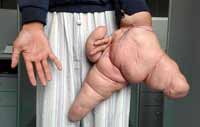Elephantiasis and progeria are just a few of world’s most horrendous diseases
It is hard to believe that there are diseases that can make your members grow out of all proportions or make the body experience all stages of life from early childhood to extreme old age in just ten years. Unbelievable as it may seem, over 100 million people on earth suffer from extremely weird diseases.

Walking corpse syndrome
People suffering from this condition may believe that they have lost parts of their bodies or even their souls and some might go as far as to really believe that they are already dead and are indeed a walking corpse, even maintaining that they can smell their own rotting flesh and can feel the worms eating at them. It has also been associated with psychosis linked to drugs such as amphetamines and cocaine and to schizophrenia.
Beheaded body can take 32 steps (read article)
Vampire disease
This disease is characterized with the feeling of pain caused by the sun. Those suffering from the werewolf syndrome are forced to avoid the sun. Once exposed to the sun, their skin begins to blister and literally burn under the influence of sunlight. Such symptoms remind one of vampire qualities and was therefore named after the mystic creature of the night.
Jumping Frenchman of Maine Disorder
This is an extremely rare disorder first described by G. M Beard in 1878 and is believed to have been first observed in French Canadian Lumberjacks. Sufferers have a sudden and an abnormal reaction to stimuli. For example, when given a sudden command in a loud enough voice the individual will carry out that command instantly and without a thought, even if you tell them to hit out a loved one, or throw an object. Also, on hearing unfamiliar or foreign phrases they will often repeat them over and over again uncontrollably. Other symptoms include extreme jerky movements whenever a loud noise is heard, hence the “jumping” aspect to this disorder.
Blaschko's lines: strange stripes all over the body
Blaschko's lines are an extremely rare and unexplained phenomenon of human anatomy first presented in 1901 by German dermatologist Alfred Blaschko. Neither a specific disease nor a predictable symptom of a disease, Blaschko's lines are an invisible pattern built into human DNA. Many inherited and acquired diseases of the skin or mucosa manifest themselves according to these patterns, creating the visual appearance of stripes. The cause of the stripes is thought to result from mosaicism; they do not correspond to nervous, muscular, or lymphatic systems. What makes them more remarkable is that they correspond quite closely from patient to patient, usually forming a "V" shape over the spine and "S" shapes over the chest, stomach, and sides.
Pica: the urge to eat non-food substances
People diagnosed with Pica have an insatiable urge to eat non-food substances like dirt, paper, glue and clay. Though it is believed to be linked with mineral deficiency, health experts have found no real cause and no cure for this disorder.
Alice in Wonderland Syndrome
Alice in Wonderland syndrome (AIWS), or micropsia, is a disorienting neurological condition which affects human visual perception. Subjects perceive humans, partsof humans, animals, and inanimate objects as substantially smaller than in reality. Generally, the object perceived appears far away or extremely close at the same time. For example, a family pet, such as a dog, may appear the size of a mouse, or a normal car may look shrunk to scale. This leads to another name for the condition, Lilliput sight or Lilliputian hallucinations, named after the small people in Jonathan Swift's Gulliver's Travels. The condition is in terms of perception only; the mechanics of the eye are not affected, only the brain's interpretation of information passed from the eyes.
Blue Skin Disorder
A large family simply known as the "blue people" lived in the hills around Troublesome Creek in Kentucky until the 1960s. They were the blue Fugates. Most of them lived past the age of 80, with no serious illness - just blue skin. The trait was passed on from generation to generation. People with this condition have blue, plum, indigo or almost purple skin.
Blue people inhabited Kentucky in 1950s (read article)
Werewolf Syndrome
When two year-old Abys DeJesus grew dark, hairy patches on her face, doctors said she has a condition known as Human Werewolf Syndrome. The disease is called werewolf syndrome because people with it look like werewolves - except without the sharp teeth and claws. In Mexico, a large family of men had hair that covered their faces and upper bodies. Two brothers were even offered a part in the X-Files but they turned down the offer.
The interest to the werewolf phenomenon will never fade away (read article)
Elephantiasis
Lymphatic filariasis, also known as elephantiasis, is best known from dramatic photos of people with grossly enlarged or swollen arms and legs. The disease is caused by parasitic worms, including Wuchereria bancrofti, Brugia malayi, and B. timori, all transmitted by mosquitoes. Lymphatic filariasis currently affects 120 million people worldwide, and 40 million of these people have serious disease. When an infected female mosquito bites a person, she may inject the worm larvae, called microfilariae, into the blood. The microfilariae reproduce and spread throughout the bloodstream, where they can live for many years. Often disease symptoms do not appear until years after infection. As the parasites accumulate in the blood vessels, they can restrict circulation and cause fluid to build up in surrounding tissues. The most common, visible signs of infection are excessively enlarged arms, legs, genitalia, and breasts.
Progeria
Progeria is caused by a single tiny defect in a child's genetic code, but it has devastating and life-changing consequences. On average, a child born with this disease will be dead by the age of 13. As they see their bodies fast forward through the normal process of ageing they develop striking physical symptoms, often including premature baldness, heart disease, thinning bones and arthritis. Progeria is extremely rare, there are only around 48 people living with it in the whole world. However, there is a family that has five children with the disease.
Newborn child may turn into 80-year-old person within one year (read article)
Source: agencies
Subscribe to Pravda.Ru Telegram channel, Facebook, RSS!





